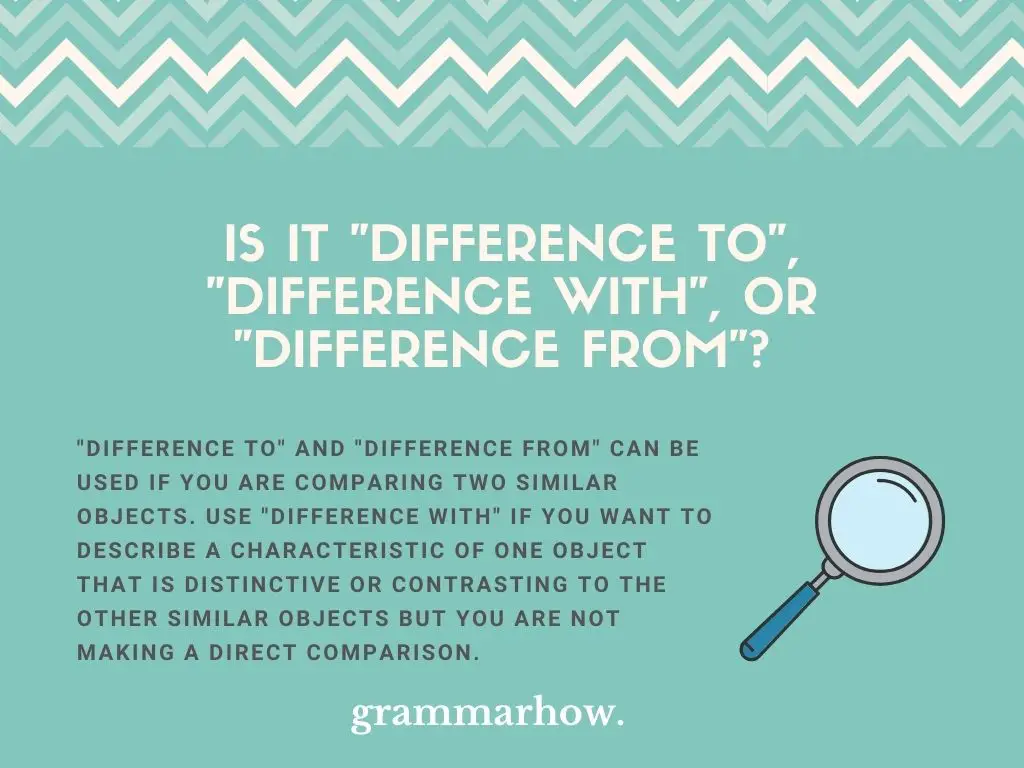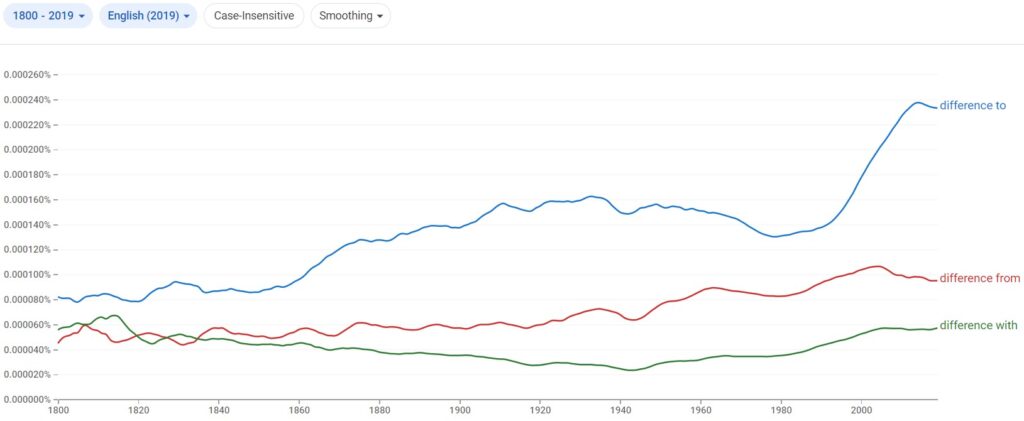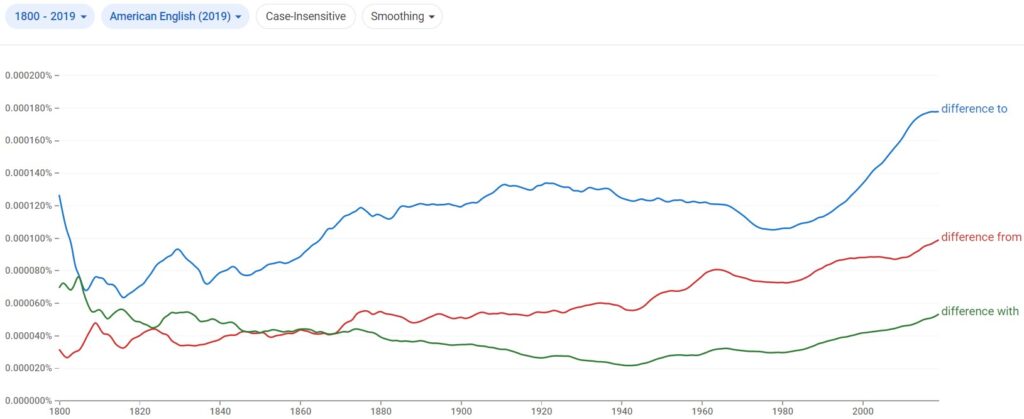When we want to make a comparison between people or objects, we often use a variation of the word “difference” along with a preposition. This article will help you to determine the best preposition to use with the word “difference” to secure a proper understanding from your audience.
Is it “Difference To”, “Difference With”, or “Difference From”?
“Difference to” and “difference from” can be used if you are comparing two similar objects. Use “difference with” if you want to describe a characteristic of one object that is distinctive or contrasting to the other similar objects but you are not making a direct comparison.

Prepositions can always be a bit confusing, and these examples are no exception. Sometimes just saying it in your head won’t give you the clarity that you need as many of them “sound correct” but should be said another way. Here we will break down these three phrase variations individually so you can see some specific examples and better understand the rules for usage.
When Should I Use “Difference To”?
“Difference to” seems to be more common in the use of British English and tends to be preferred when there are additional words separating “difference” and “to.” This format of wording is not particularly popular or used in American English and has to be worded carefully so as not to sound awkward.
Let’s look at some examples where it is worded in a way that makes sense.
- The twins had no difference at first to each other. It was only after really getting to know them, that you realized they had many distinctions.
- The piece of art seemed to have many differences to other pieces by the same artist, but a closer inspection revealed that it still did have many of his signature characteristics.
Notice in the first of the two examples that the words “difference” and “to” are separated by the phrase “at first.” In the second example, there is no separation between the two words.
When Should I Use “Difference With”?
When you say “difference with,” you are pointing out a main characteristic that one object or person has that is not at all like the other. Use this wording, not to make a comparison between the two things, but to explicitly show that one of them is unique in some way.
Using the preposition “with” can sometimes make the sentence sound awkward so it is not as commonly used as the other prepositions. As you will see later in this article, a more common way to point out a specific difference is to use the preposition “between.”
Look at a couple of these sentences to see how “with” gets the point across, but does not sound as smoothly as the other prepositions.
- The difference with ice cream and sorbet is that sorbet never uses milk as an ingredient.
- The difference with the two schools is that one focused more on science and math and the other primarily on liberal arts.
When Should I Use “Difference From”?
You will find “difference from” rising in popularity in the United States throughout the years, especially in conversational language. It is used to make a direct comparison between two or more objects, similar to how “difference to” is found commonly in British English.
- The only difference from that park to the other one nearby is that it has walking trails and the other does not.
- The only difference from that school to the one down the street is that it offers a few more options for classes.
- Regarding the types of people who chose to live there, you’ll find a great difference from one side of town to the other.
How Prevalent Is The Use of “Difference To”, “Difference With,” and “Difference From”?
As we touched upon in our previous explanation, “difference with” appears to be the most infrequently used version of these three phrases. This fact proves itself even further when we look at some statistics that compare the usage within books published throughout the years.
The Google Ngram Viewer graph that we see here shows that “Difference To” has always been the most prevalent of the three phrases, even as far back as the 1800s.

In modern times, this phrase has separated itself even further than the others in popularity, and in the early 1990s, we see a sharp jump in its usage as compared to the others.
Is “Difference To”, “Difference With”, and “Difference From” Used Differently In The UK and The US?
We mentioned above that “difference to” is a more popular expression in British English and that “difference from” is commonly used in conversational American English. We can back up our distinctions by looking at some data from Google showing books published in the US vs. in the UK..
This Google Ngram Viewer shows the prevalence of the three phrases in American English over the years. You can see that “Difference To” appears to hold steady as the most used phrase, at least in books, even in American English.

In recent years, however, “Difference From” shows some increase in popularity which may suggest that books are being written in a more conversational tone. Both options still have greater popularity and more frequent use than the use of “Difference With.”
When we look at a comparison in British English, this Google Ngram Viewer shows a similar pattern, with “Difference To” always being the most popular option of the three phrases. As we previously mentioned, it has steadily increased in popularity since the early 1900s and took a big jump in popularity in the early 1990s.

This graph backs up our statement that “Difference To” has always been more popular in British English than it has been in American English.
Which Other Prepositions Can Be Used With “Difference”?
You will often see other various prepositions used with the word “difference,” depending on the tone of voice and comparison being conveyed. The prepositions “between,” “within,” “among,” “of,” “in,” and “than,” are all found in conjunction with the word “difference” and used in both conversation and written word.
Let’s explore these other options in more detail, so you can be sure when to use each of them and avoid making common mistakes that sound awkward or don’t make sense.
Difference Between
Use “Difference Between” when you want to compare or know the relationship or connection for two objects or people.
These sentences give an idea of this usage.
- What is the difference between a clam and an oyster?
- There is a difference of four years between the two siblings.
- Can you tell the difference between the two types of soda?
Difference Within
Use “Difference Within” if you want to describe an estimate of a difference or something inside of boundaries. Keep in mind that the word “within” doesn’t imply something very specific, so your audience may interpret it differently based on the overall context.
Let’s look at some examples.
- The difference of variations within the species of fish was so slight, the average person would not notice them.
- There are many differences of dialect within the United States and someone who is visiting will notice them as they travel from region to region.
- The differences within the group of friends were many, but they still all got along really great.
Difference Among
You may choose to use “Difference Among” if you are comparing and contrasting more than two objects or people. The word “among” implies that there are more than two things, or a larger set.
Notice how in these sentences, there are several or many things being compared.
- The differences among viruses are so numerous, that it is nearly impossible to catalog them all.
- What are the differences among the four types of fishing poles? I want to select the best one.
- The differences among all of the students in the class were many, but the teacher tried to make sure that she taught in a way they could all understand.
Difference Of
“Difference Of” indicates the extent of the difference, and is often used mathematically, as a way of indicating the measure between two objects.
Look at these examples to see how the phrase is used to describe measure.
- There is a difference of 2 meters between the tables.
- There is a difference of 20 degrees F between the outside and the inside of the house
- The peaks of the two mountains have a difference of 1300 feet.
Difference In
If you want to talk specifically about the characteristic that you are comparing for two things, you would use the preposition “in.” You would not use this preposition to talk about specific measurements, as in the examples above, but you can use it to ask about the difference in a measurement (i.e., the difference in length).
Make sure that you want to compare a specific characteristic, before using this preposition, like in these examples.
- What is the difference in meaning between the words “like” and “affection?”
- What is the difference in height between you and your sister?
- What is the difference in size between the two varieties of rose bushes?
Difference Than
“Difference Than” is worth mentioning because “than” is a popular preposition used in comparisons. However, saying “difference than” is not correct phrasing and you should avoid using it in this format because it not only sounds awkward, but is also grammatically incorrect. If you want to use the preposition “than,” you must use it with the word “different” and not with the word “difference.”
Let’s see some examples of correct and incorrect usage.
- Correct: Football is different than rugby and does have many similarities.
- Incorrect: Football has difference than rugby and does not have many similarities.
- Correct: My shirt is different than my sister’s, but it almost looks like it’s the same shirt from a distance.
- Incorrect: My shirt has difference than my sister’s, but looks like the same shirt from a distance.
- Correct: Although they are more different than they seem, Steve and Laura still make a great couple.
- Incorrect: Although they have more difference than they seem, Steve and Laura still make a great couple.
So you can see from the examples, that the only proper way to use the preposition “than” when comparing objects is to use it with the word “different.” It sounds clumsy and causes the sentence not to flow smoothly.

Martin holds a Master’s degree in Finance and International Business. He has six years of experience in professional communication with clients, executives, and colleagues. Furthermore, he has teaching experience from Aarhus University. Martin has been featured as an expert in communication and teaching on Forbes and Shopify. Read more about Martin here.
